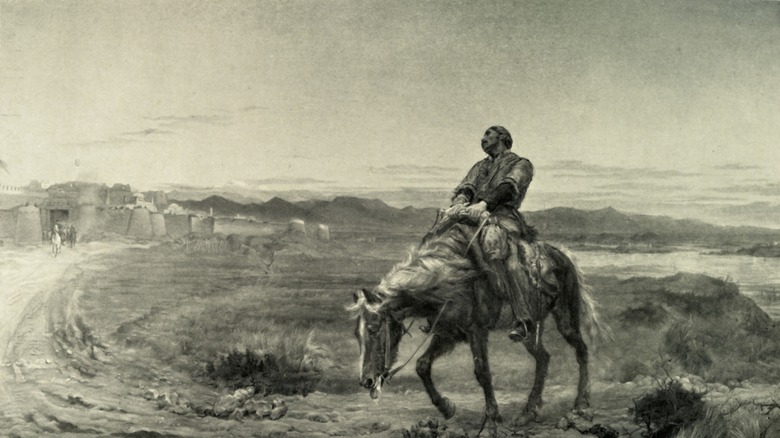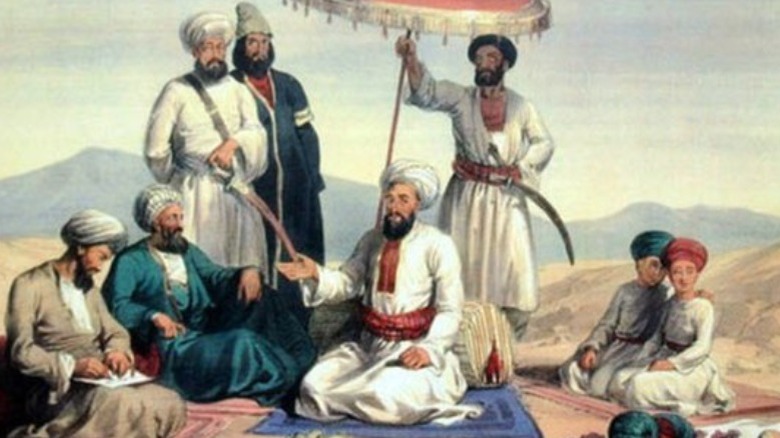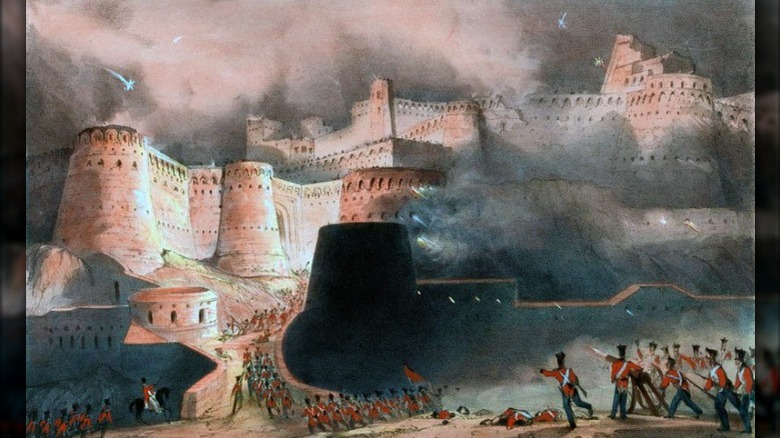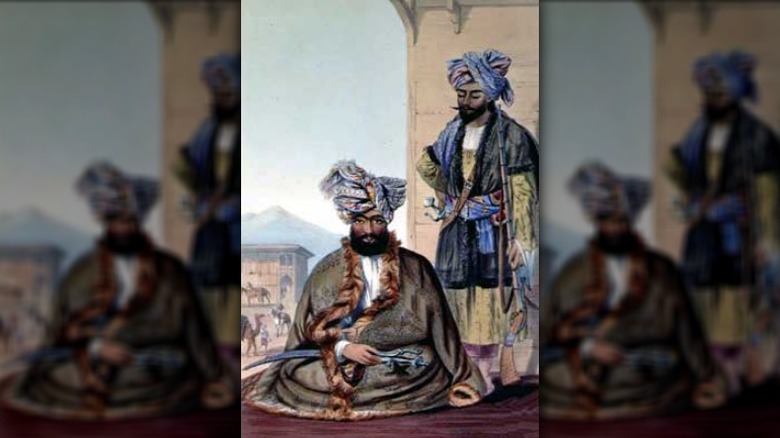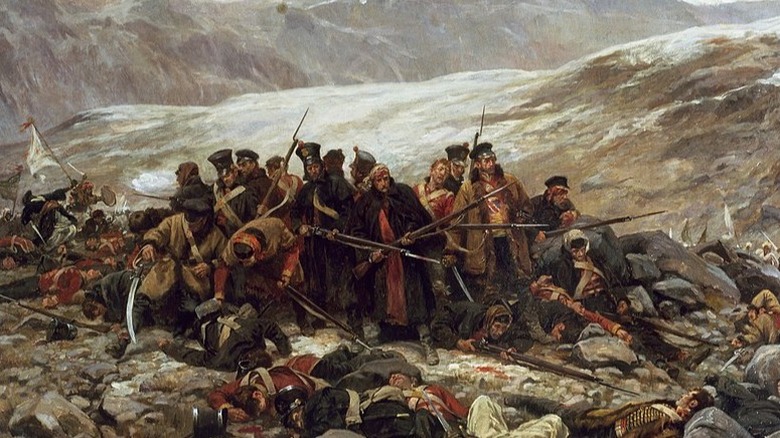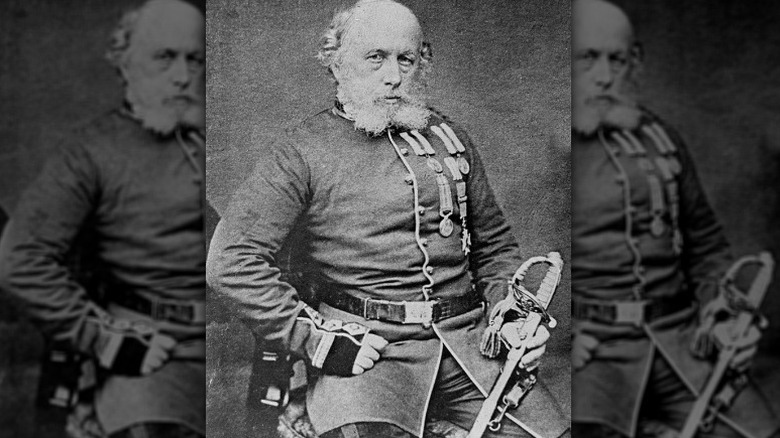Who Was Dr. William Brydon, The Alleged Lone Survivor Of Britain's Massacre In Afghanistan?
On January 6, 1942, British forces occupying Afghanistan were in a dire situation after installing their own puppet government in the nation two years prior (via History). An army of Afghan soldiers led a revolt against their imperialist masters, leaving the British no choice but to retreat. A group of roughly 16,000 soldiers withdrew from their position, attempting an escape from enemy forces. This would prove to be an impossible task, however, as the combined factors of unfavorable weather conditions and the brute strength of the Afghans supposedly ended in the massacre of every single British troop — except for Dr. William Brydon.
After a long week, Brydon, joined by three other soldiers, was in the final stretch to Camp Jalalabad, a city out of reach of the Afghan insurgency. During the journey, the group was intercepted, and Brydon's companions were slain in battle, whereas Brydon and his steed were wounded, according to Brown University. Eventually, utterly exhausted by the journey, Brydon was rescued by soldiers in the camp, where he recounted the story of what happened to his fellow men.
Tensions rise
Years prior to the British retreat, Afghanistan found itself caught in the conflict between two geopolitical powerhouses, Great Britain and Russia. The British feared that Russia was planning an invasion of India — a crown jewel of the British Empire at the time — by sending soldiers through Afghanistan. So, in 1837, the British sent an ambassador to meet with Dost Mohammad Khan, the king of Afghanistan (via the National Army Museum).
Negotiations had gone well until Mohammad declined the British's request to invade Peshawar, which had been conquered by Sikhs three years earlier. Diplomatic relations between Afghanistan and Great Britain fell through as a result, and this made leading British politicians paranoid. This anxiousness was validated when the Persians, who were allied with Russia at the time, invaded the city of Herat, Afghanistan, creating a clear pathway for Russia to invade India. Consequently, the governor and general of India, Lord Auckland, ordered an invasion of Afghanistan to protect British interests (via Britannica).
Victory at first glance
In December 1838, British forces began to mobilize troops to be sent to Afghanistan. Four months later, on April 25, 1839, the British successfully entered the city of Kandahar (via Military History). Before they reached the city, Dost Mohammad Khan's brother had been the presiding ruler but fled to Kabul, the capital of Afghanistan, after word arrived that the British were near. Therefore, it didn't take much effort for the British to swiftly occupy the area, according to National Army Museum.
The British then named an exiled Afghan leader, Shuja, the new Shah of Afghanistan, and marched to Kabul to overthrow Dost Mohammad's government. However, they were at an impasse when passing through Fort Ghazni, a heavily protected Afghan fort. Due to the help of spies and military might, the British were able to break through the fortress, something that was once thought to be an insurmountable task. Not long after, the British forces marched into Kabul, establishing Shah Shuja as supreme leader, according to Military History.
Civil unrest
This wasn't the end of the war. Rather, the Afghan people grew to resent the British occupation. Originally, British troops did begin to leave the nation, but Shah Shuja had brought with him some unpopular policies. He worsened relationships with local leaders in the region and also worked with not-so-ethical people who were accused of "womanising and raucous behaviour," according to Military History. But the British fumbled the political football when the chief British ambassador to Afghanistan, William Hay Macnaghten, permitted British soldiers to bring their families to Kabul. The Afghans took as a sign of permanent occupation, sparking rebellion.
The British soldiers staying in Kabul were forced to leave the city, and they camped just outside the walls. Soon enough, however, the Afghan people, led by Muhammad Akbar Khan — the son of the previous leader Dost Mohammad Khan — executed William Macnaghten along with other diplomats. British forces surrendered, which led to their retreat and subsequent massacre, according to the National Army Museum.
Dr. William Brydon
Then enters Dr. William Brydon, the combat surgeon who would be immortalized for being the lone European survivor of the British forces leaving Kabul. Born in 1811, Brydon was a member of the Bengal Army, which was a private army owned by the East India Company. Given that the corporation had attained lots of land during the early 19th century, it was necessary for them to protect their economic interests. With the support of the British and paying local soldiers, the company created three separate armies, the Bengal Army being the largest, according to the National Army Museum.
Thirty-seven years after Brydon's famous escape, Lady Elizabeth Butler, a famous British artist, depicted Brydon in a painting called "The Remnants of the Army," according to Brown University. Butler depicted Brydon in a manner that showed just how deadly the retreat was, with Brydon himself being seriously distressed. Today, the painting is at the Royal Academy for viewing, but scholars point out that the story of Brydon being the lone survivor may not be entirely accurate (via Brown University). According to the National Army Museum, it is likely that some Indians in the army at the time of retreat escaped, but Brydon was the only European to live and recount the story.
Lifelong veteran
After the First Anglo-Afghan War, Dr. William Brydon took some time to recover but eventually got caught up in the Second Anglo-Burmese War. After 20-odd years of peace with Burma, British business owners accused the Burmese of extorting merchant ships after two were detained and fined by the Burmese government. The situation spiraled out of control when a British officer disobeyed diplomatic orders after the Burmese rescinded their fines and sent the two nations into war. (via Lost Footsteps).
Eventually, the British captured Rangoon, which is when Brydon entered the war as a surgeon once again. When the Burmese conducted a raid on his home in Lucknow, he and his family escaped, being wounded in the process. They all survived, and by the end of his career, Brydon had been promoted to surgeon-Mmajor, a position he held until 1864 (via the National Army Museum). Brydon died nine years later, leaving behind the legacy of the only confirmed British soldier to tell the story of what happened after imperial powers angered local populations, leading to revolution and massacre.
